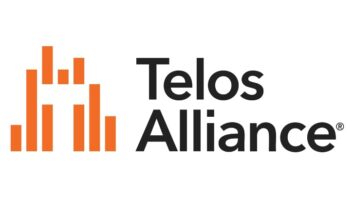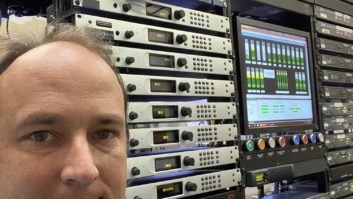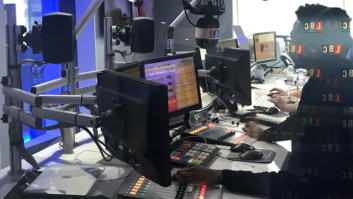I know there are many legacy analog audio plants still running in radio stations in the U.S. (and the rest of the world). Undoubtedly some of them are a little �dog-eared� and frayed around the edges. If you are in charge of a plant like this, it�s time to consider your options, so that you�ll be ready for the planning of upgrades, or to build an entirely new plant. In this article, we�ll look at many of the options available to you: Not only the newer audio over Internet protocol systems, but time domain multiplex systems that support AoIP interfaces, as well.
Before we look at the various vendors for AoIP systems, let�s review, very briefly, the basic premise of an AoIP network.
In a TDM system, a large �core� audio router ingests all the audio sources, and in turn has connections to all the destinations on the network. Inside the router is a cross-point (electronic) switch; this is where a source is connected to an amplifier that drives the signal to the far-end destination. More than one destination can be connected to the same source; and often multiple sources are added to make a bus. The core is at the center of a spoke-and-hub system; spoke connections are made via TDM, which is a synchronous serial data stream. Each �time-slot� is associated with a digital audio path. The major components of the system are always proprietary to the particular manufacturer.
The first two AoIP systems we�ll talk about use a distributed system of audio inputs and outputs and logic control; this is a fundamental difference with respect to the TDM (core) systems. Whereas TDM systems generally make use of proprietary hardware for the interconnection of studios to the hub, the first two AoIP systems provide the routing and interconnection via what really boils down to a local area network, built using CAT5e, CAT6 or fiber connections, and commonplace, high-quality layer-2 (Ethernet) switches.
Wheatstone is a very well known AoIP system manufacturer, with multiple consoles choices. The LX-24 is a low-profile, tablet-top console, with 24 input modules, four stereo busses, four pre-fader Aux sends, four mix-minus busses, a stereo cue buss and a bus-minus output for each fader. An LED source name display, an A/B source selector and two programmable soft buttons are also available, and a Set button provides access to assignable controls in the master section. The modules are hot-swappable down to the individual fader.

The LX-24 works in conjunction with an IP88E Blade 3, which contains all of the DSP processing to support the control surface. (Each Blade in the Wheatstone system is a single-RU form factor.) The IP88E doesn�t house audio I/O, but it does include 12 universal logic (GPIO) ports for interfacing various external switches, indicators and devices for control purposes. All the audio inputs and outputs of the system are done by way of additional Blades, each of which has a specific purpose: microphone level inputs; analog inputs/outputs; AES inputs/outputs; mixed analog/AES; digital logic blades. The audio blades are AES67 compatible.
The E-6 is another console option from Wheatstone. Like the LX-24, it�s meant to work inside the Wheatnet AoIP system, connecting via a single CAT6 cable. It has a low profile but can drop in to a counter-top cutout, with frame size up to 24 channels. E-6 has four stereo output busses; four mix minus busses; individual fader mix-minus outputs with talkback; and, four aux output busses. Line inputs have eight-character source displays. A meter bridge is optional; alternatively, you can use a VGA monitor to display console metering, with clock and timer as well. The same monitor is use in conjunction with a touchpad and left/right click buttons, built in to the console surface, to access infrequently used controls, and for console programming.
As with the LX-24, you can save a copy of the console configuration, recalling it for later use: all sources, bus assignments, and other settings. Different levels of user access are available, so that more experienced users can complete more complex tasks.
Axia is another very well-known manufacturer of AoIP networked systems. One of their consoles choices is known as Element; it�s a modular console, with frames available in sizes from four to 28 positions, with support for up to 40 faders in multiple, linked frames. The Element control surface works with the Axia PowerStation and StudioEngine DSP mixing engines and connects to the Axia network with a single CAT6 Ethernet cable. Element features four stereo program buses, four send buses, two return buses and a number of VMix (Virtual Mixer) channels, which allow combining up to five audio sources for presentation on a single console fader. A variety of module types provide control of mic/line inputs, telephones and other devices.

Another console choice is the Axia iQ � which can operate as a standalone console, or be connected to Axia network. iQ is a console system that can be used to build custom consoles of sizes from eight to 24 faders. The basic system consists of one iQ 9-Fader Main Frame and one QOR.32 integrated console engine, which incorporates analog and digital audio I/O, GPIO and a custom Ethernet switch. iQ features three dedicated stereo Program buses, plus a stereo Utility bus that can be used for phone calls, off-air recording, or as a fourth program bus. Automatic mix-minus is provided on each fader, plus talkback functions, one-button off-air record mode, show profile functions for instant recall of up to four pre-defined console �snapshots,� high-resolution OLED program meters switchable between VU and PPM metering styles, OLED option and source name displays on each fader strip, studio and control room monitor.
Audio ingress and egress can be done on an Axia network by way of xNodes, which are 1 RU in height, half-rack in width, and available in analog, AES, microphone-level, mixed-signal and GPIO versions. They can be powered by way of AC or Power-over-Ethernet. xNodes are AES67-compatible.
It�s also important to consider that any device that is Livewire compatible will �talk� directly via Ethernet with the Axia network.
Logitek is another manufacturer of console and router systems, including both AoIP and TDM types. The ROC will serve in on-air or production rooms as an integral part of the Jetstream AoIP platform. It�s available in sizes up to 24 slots (with 18 channels) though it can be expanded with additional banks of six channels. Four assignable output busses; Penny & Giles 100 mm long throw faders; an optional meter bridge that displays program and switched source levels with dual OLED screens for timers, clock, profanity delay indication or user-defined text.

Another option from Logitek is the Mosaic, also an integral part of the JetStream AoIP Audio Networking platform. The Mosaic is presented in a counter-top design that allows one to move the board out of the way when not needed. It�s available in sizes ranging from four to 24 faders, with two options for meter bridges. OLED screens are used throughout for source identification and confidence metering; illuminated rotary controls and programmable backlighting for on/off and selector buttons allow custom color-coding for operators. As with all Logitek consoles, any source can be assigned to any fader, and each fader provides easy access to control functions as well as indication of bus assignments and level metering.
The JetStream Mini is an integrated console engine and AoIP routing platform, handling console functions as well as audio routing duties. One JetStream Mini can support up to 128 digital or analog inputs/outputs; 24 mix-minus busses (assignable to any fader of any Logitek console connected to the router); nine program busses; 32 channels of stereo audio shared between one to four Logitek consoles; EQ and dynamics processing assignable to any fader; and fader input metering with audio level alarms. StudioHub+ inputs may be directly connected; breakouts are also available for DB25, XLR, BNC (digital I/O) and punch blocks.
Another important aspect of the JetStream AoIP system is that it now incorporates Livewire connectivity protocols and provides direct network connectivity to all Livewire partners. According to Logitek�s Web page, JetStream is compatible with Ravenna and AES67.
The manufacturers of more traditional TDM console/router systems are providing AoIP options for their new and continuing customers as well. As an example, SAS is now offering the KEL-16 and KDL-16 plug-in modules for their well-known 32KD routing system. The KDL-16 module provides 32 channels of 24-bit linear audio, and utilizes the Dante AoIP protocol from Audinate; it also supports AES67 and Audio-Video Bridging (AVB). The KDL-16 is suitable for direct ingest of audio from digital audio workstations over an IP LAN or WAN and comes with audio sound card drivers (or Virtual Sound Device Software) that supports both WDM for PC Windows and ASIO for Mac OS systems.
The KEL-16 provides 32 channels of selectable Bit Rate Reduced algorithms (such as AAC-LC) for use over standard IP LANs and WANs, making it suitable for the transport of multiple channels of encoded audio to and from any location that has IP connectivity. It can also be used to connect multiple 32KD routers together via IP, with all 32 channels of bidirectional audio using about 2 Mbps of bandwidth.
GatesAir is adding a new element to their VistaMax (TDM-based) console/router systems � the VMXpress IP. This device is an AoIP gateway for the VistaMax system, using RAVENNA; as such, VMXpress-IP is AES67-compliant. The benefit of the AES67 standard is that the AoIP streams going out of VMXpress-IP will talk directly with other manufacturers products that are also AES67-compliant; that could include studio gear, audio processors, STL systems, and the like. Conversely, VMXpress-IP will provide a means by which other AES67-compliant devices can communicate directly with the VistaMax routing system.

There are many console and routing system manufacturers from outside of North America that are worth considering when you upgrade your plant. I realize that there is a certain reticence in looking to overseas manufacturers when it comes to systems such as this. A primary concern is potential difficulties related to customer support with respect to language and time zone differences; however, I would look at the functionality, features and quality of construction first, as they really are more important than whether or not you can get customer support over the telephone. Much of that will be done via email, regardless.
Lawo is a well-established German manufacturer of consoles and routing systems. Their radio consoles include the crystal series (up to 16 faders) and sapphire series (up to 60 faders); their routing systems are based on TDM connectivity. In a typically sized radio station facility, one would likely consider the Nova17 router, which supports up to 128 inputs and outputs with its standard analog and AES plug-in cards. An optional type of plug-in module for the Nova17 is the multichannel audio digital interface (MADI � also known as AES10) that supports up to 64 channels of audio; six of those can go in the Nova17 frame, thus ultimately allowing for up to 512 audio inputs and outputs in a 3RU frame.

Lawo is taking the �hybrid� approach to AoIP inside of its console and router systems. They�re about to introduce another plug-in module, which is a 64-channel hybrid MADI/IP extension card for the sapphire and crystal radio consoles as well as the Nova17. Introduction of these cards in to existing systems allows for migration to AoIP audio sources (specifically, Ravenna/AES67).
AEQ is another manufacturer of consoles and TDM-based routing systems. The BC2214 AoIP plug-in card is designed to be installed in either AEQ�s BC2000D frame (part of the Arena digital console systems) or in the Titan routing system. The inclusion of multiple copies of this card in the BC2000D frame would provide an ARENA console with access to as many as 512 audio inputs and outputs. AEQ�s Netbox audio interfaces are used to get audio in and out of the routing system. The Netbox 32 AD has 32 inputs and outputs organized in to groups of 16 mono analog and 8 stereo digital channels. In addition, it accommodates 16 GPI/O, in a 1-RU form factor. The Netbox 8 AD is a similar device, with half-rack width, and supports eight inputs and eight outputs and four GPI/O. Both Netboxes communicate to the routing system by way of Ethernet, with two RJ45-style ports available. Audio and controls interfaces are done by way of db15 connectors.

AEQ has a Florida-based U.S. office, by the way, so service-after-sale questions can be forwarded to them.
Having spent many years maintaining analog radio studios, and after quite a few analog console installations, I�m not ready to simply write them all of as ancient history. However, the reality is that all consoles and systems eventually wear out (even if it does take 25 years); inevitably, as an engineer in charge of a studio plant, you will one day face that fact. It�s always a good idea to keep abreast of the latest technology, even if you are not planning a build in the immediate future. That way, when the day comes that you learn a new plant is needed, you�ll likely have a system in mind, and you�ll be able to formulate your plan quickly and painlessly.







